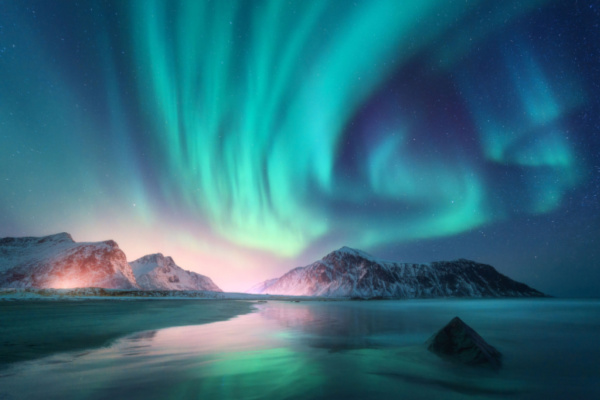Fans of the aurora borealis phenomenon had a feast for the eyes last week, as Geomagnetic Storms lit up the night skies. If you missed it, don’t worry, because federal forecasters are saying the auroras are likely to return this week.
As NBC News reports, in addition to the U.S., there have reports of sightings in Germany, Switzerland, China, England and Spain. The timing is not bad for viewers, although aurora spotters may have to be up at last call to get the best look.
National Oceanic and Atmospheric Administration (NOAA) forecasters say the geomagnetic storm activity underlying the bursts of northern lights would likely return at full strength on Sunday. The latest forecasts from the center have Earth-affecting geomagnetic storm activity taking place Monday and possibly into Tuesday.
“Severe and extreme” geomagnetic storms were likely, the NOAA’s Space Weather Prediction Center said in a forecast statement.The storms are producing massive solar flaring in an area of sun spots that faces Earth, the center said. The geomagnetic impacts were likely to continue until that part of the sun rotates away, it said.
“Severe storm levels” were expected on Sunday, “active to severe storm levels” on Monday, and “unsettled to minor storm levels” on Tuesday, the center said in a forecast published on Saturday.
The solar activity accelerates electrons as they aim for Earth and ultimately collide with oxygen and nitrogen atoms and other molecules in the upper atmosphere. The collisions with the gases of the upper atmosphere create the wondrous colors of an aurora sky.
The phenomenon is rarely viewable in the United States, and if it is, it’s usually for those in the northern reaches of the continent. But the intensity of the geomagnetic storms has pushed the viewing area further south this weekend, with reports of sightings in Louisiana, Alabama and Mississippi.
The predominance of a dark new moon that began May 7 could clear the stage once again for the northern lights to shine. The moon is about one-fifth full this weekend, according to NASA. But federal forecasters said earthly storm activity, mostly rain, was expected on Sunday from Kansas to Texas, where viewing might not be as easy as it has been.
The measurements demonstrate the most powerful geomagnetic storm to affect Earth since the “Halloween Storms” of 2003, said center spokesperson Bryan Brasher. “A lot of energy is being fed into the Earth’s field,” he said.
Viewing is usually best just on either side of midnight — roughly from 10 p.m. to 2 a.m. — experts say. Saturday night and Sunday night look like show nights, and Monday viewing seems possible, if not likely.Since Friday, there have been at least three readings of G5 intensity from the geomagnetic storm, using a scale of 1-5, with G5 being “extreme” in energy, according to the Space Weather Prediction Center.
—
Photo Credit: Denis Belitsky / Shutterstock.com
